NVIDIA's GeForce GTX 580: Fermi Refined
by Ryan Smith on November 9, 2010 9:00 AM ESTPower, Temperature, and Noise
Last but not least as always is our look at the power consumption, temperatures, and acoustics of the GTX 580. NVIDIA’s performance improvements were half of the GTX 580 story, and this is the other half.
Starting quickly with voltage, as we only have one card we can’t draw too much from what we know, but there are still some important nuggets. NVIDIA is still using multiple VIDs, so your mileage may vary. What’s clear from the start though is that NVIDIA’s operating voltages compared to the GTX 480 are higher for both idle and load. This is the biggest hint that leakage has been seriously dealt with, as low voltages are a common step to combat leakage. Even with these higher voltages running on a chip similar to GF100, overall power usage is still going to be lower. And on that note, while the voltages have changed the idle clocks have not; idle remains at 50.6MHz for the core.
| GeForce GTX 480/580 Voltages | |||||
| Ref 480 Load | Ref 480 Idle | Ref 580 Load | Ref 580 Idle | ||
| 0.959v | 0.875v | 1.037v | 0.962v | ||
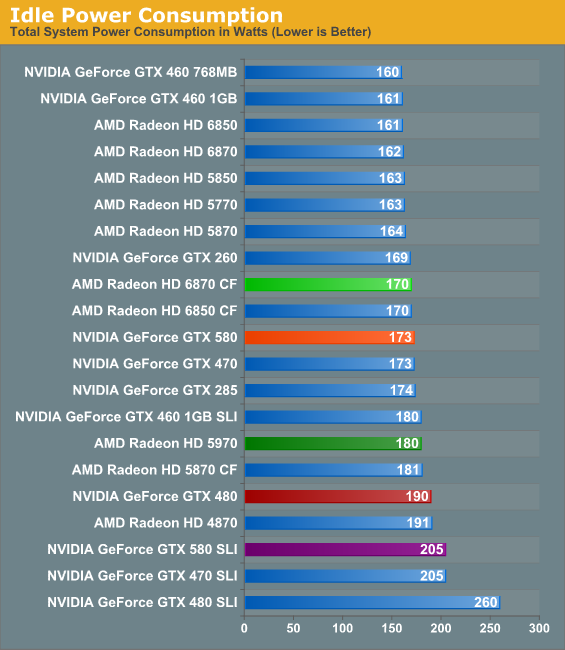
Beginning with idle power, we’re seeing our second biggest sign that NVIDIA has been tweaking things specifically to combat leakage. Idle power consumption has dropped by 17W on our test system even though the idle clocks are the same and the idle voltage higher. NVIDIA doesn’t provide an idle power specification, but based on neighboring cards idle power consumption can’t be far off from 30-35W. Amusingly it still ends up being more than the 6870 CF however, thanks to the combination of AMD’s smaller GPUs and ULPS power saving mode for the slave GPU.
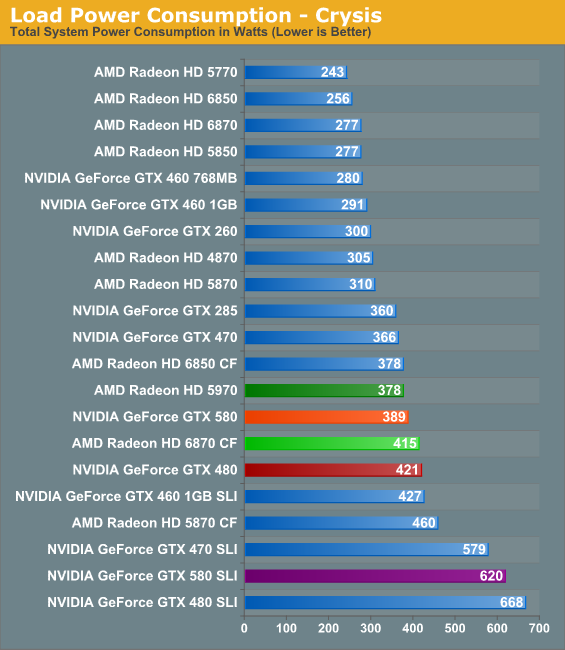
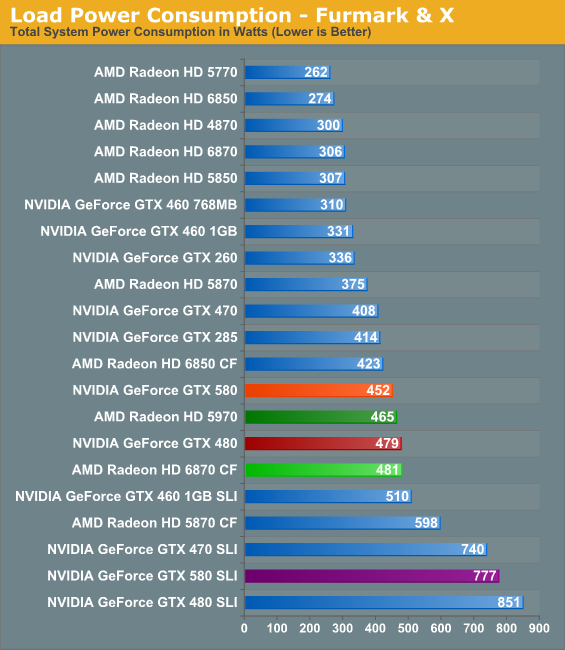
Looking at Crysis, we begin to see the full advantage of NVIDIA’s optimizations and where a single GPU is more advantageous over multiple GPUs. Compared to the GTX 480 NVIDIA’s power consumption is down 10% (never mind the 15% performance improvement), and power consumption comes in under all similar multi-GPU configurations. Interestingly the 5970 still draws less power here, a reminder that we’re still looking at cards near the peak of the PCIe specifications.
As for FurMark, due to NVIDIA’s power throttling we’ve had to get a bit creative. FurMark is throttled to the point where the GTX 580 registers 360W, thanks to a roughly 40% reduction in performance under FurMark. As a result for the GTX 580 we’ve swapped out FurMark for another program that generates a comparable load, Program X. At this point we’re going to decline to name the program, as should NVIDIA throttle it we may be hard pressed to determine if and when this happened.
In any case, under FurMark & X we can see that once again NVIDIA’s power consumption has dropped versus the GTX 480, this time by 27W or around 6%. NVIDIA’s worst case scenario has notably improved, and in the process the GTX 580 is back under the Radeon HD 5970 in terms of power consumption. Thus it goes without saying that while NVIDIA has definitely improved power consumption, the GTX 580 is still a large, power hungry GPU.
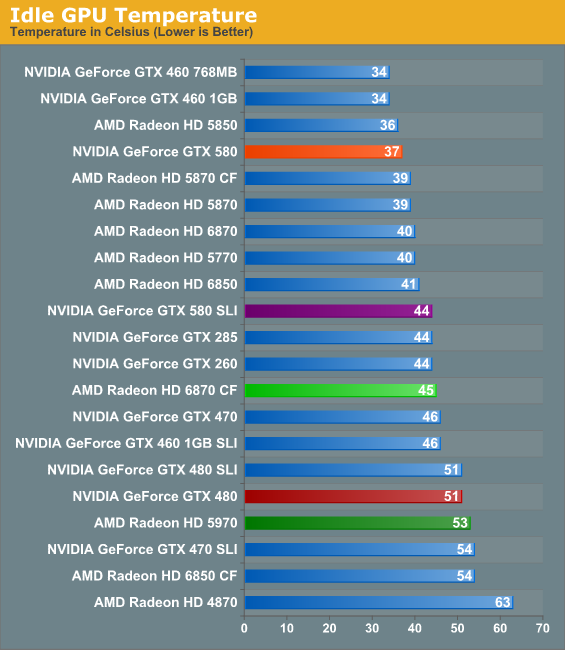
With NVIDIA’s improvements in cooling and in idle power consumption, there’s not a result more dramatic than idle GPU temperatures. The GTX 580 isn’t just cooler, it’s cool period. 37C is one of the best results out of any of our midrange and high-end GPUs, and is a massive departure from the GTX 480 which was at least warm all the time. As we’ll see however, this kind of an idle temperature does come with a small price.
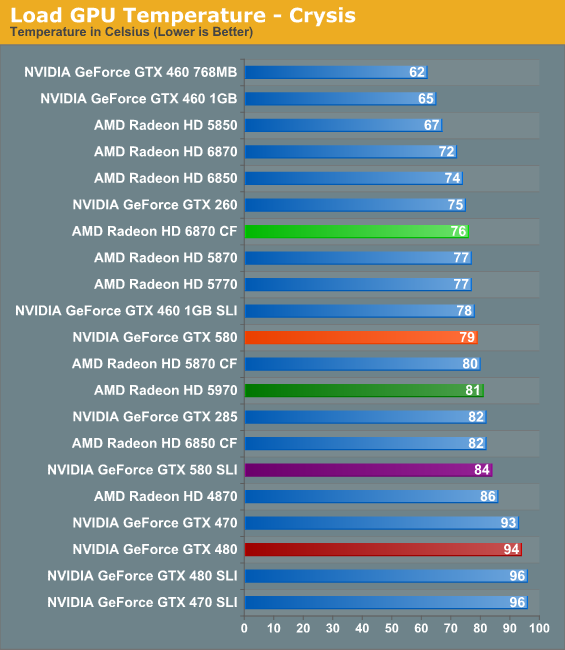
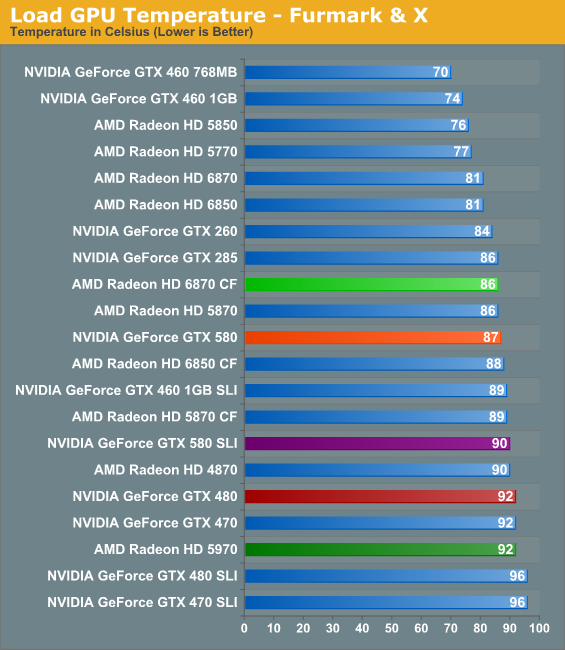
The story under load is much the same as idle: compared to the GTX 480 the GTX 580’s temperatures have dramatically dropped. At 79C it’s in the middle of the pack, beating a number of single and multi GPU setups, and really only losing to mainstream-class GPUs and the 6870 CF. While we’ve always worried about the GTX 480 at its load temperatures, the GTX 580 leaves us with no such concerns.
Meanwhile under FurMark and Program X, the gap has closed, though the GTX 580 remains in the middle of the pack. 87C is certainly toasty, but it’s still well below the thermal threshold and below the point where we’d be worried about it. Interestingly however, the GTX 580 is actually just a bit closer to its thermal threshold than the GTX 480 is; NVIDIA rated the 480 for 105C, while the 580 is rated for 97C. We’d like to say this vindicates our concerns about the GTX 480’s temperatures, but it’s more likely that this is a result of the transistors NVIDIA is using.
It’s also worth noting that NVIDIA seems to have done away with the delayed fan ramp-up found on the GTX 480. The fan ramping on the GTX 580 is as near as we can tell much more traditional, with the fan immediately ramping up with higher temperatures. For the purposes of our tests, this keeps the temperatures from spiking as badly.
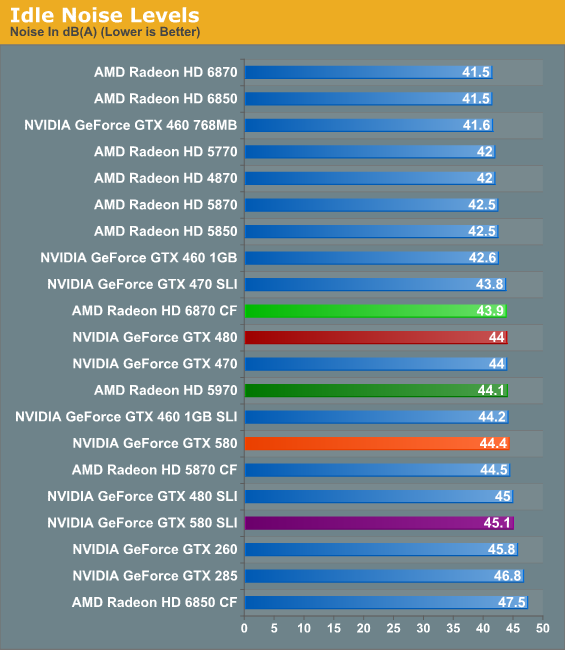
Remember where we said there was a small price to pay for such low idle temperatures? This is it. At 44.4dB, the 580 is ever so slightly (and we do mean slightly) louder than the GTX 480; it also ends up being a bit louder than the 5970 or 6870CF. 44.4 is not by any means loud, but if you want a card that’s whisper silent at idle, the GTX 580 isn’t going to be able to deliver.
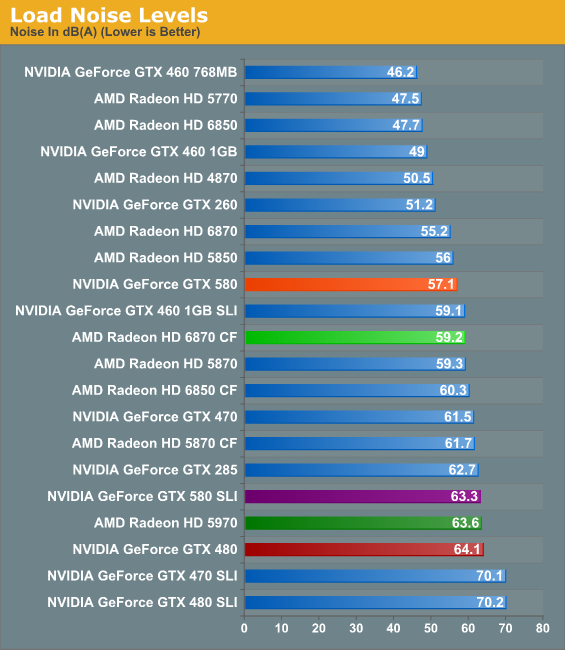
And last but not least is load noise. Between their improvements to power consumption and to cooling, NVIDIA put a lot of effort in to the amount of noise the GTX 580 generates. Where the GTX 480 set new records for a single GPU card, the GTX 580 is quieter than the GTX 285, the GTX 470, and even the Radeon HD 5870. In fact it’s only a dB off of the 5850, a card under most circumstances we’d call the epitome of balance between performance and noise. Graphs alone cannot demonstrate just how much of a difference there is between the GTX 480 and GTX 580 – the GTX 580 is not whisper quiet, but at no point in our testing did it ever get “loud”. It’s a truly remarkable difference; albeit one that comes at the price of pointing out just how lousy the GTX 480 was.
Often the mark of a good card is a balance between power, temperature, and noise, and NVIDIA seems to have finally found their mark. As the GTX 580 is a high end card the power consumption is still high, but it’s no longer the abnormality that was the GTX 480. Meanwhile GPU temperatures have left our self-proclaimed danger zone, and yet at the same time the GTX 580 has become a much quieter card under load than the GTX 480. If you had asked us in what NVIDIA needed to work on with the GTX 480, we would have said noise, temperature, and power consumption in that order; the GTX 580 delivers on just what we would have wanted.










160 Comments
View All Comments
Taft12 - Tuesday, November 9, 2010 - link
In this article, Ryan does exactly what you are accusing him of not doing! It is you who need to be asked WTF is wrongIketh - Thursday, November 11, 2010 - link
ok EVERYONE belonging to this thread is on CRACK... what other option did AMD have to name the 68xx? If they named them 67xx, the differences between them and 57xx are too great. They use nearly as little power as 57xx yet the performance is 1.5x or higher!!!im a sucker for EFFICIENCY... show me significant gains in efficiency and i'll bite, and this is what 68xx handily brings over 58xx
the same argument goes for 480-580... AT, show us power/performance ratios between generations on each side, then everyone may begin to understand the naming
i'm sorry to break it to everyone, but this is where the GPU race is now, in efficiency, where it's been for cpus for years
MrCommunistGen - Tuesday, November 9, 2010 - link
Just started reading the article and I noticed a couple of typos on p1."But before we get to deep in to GF110" --> "but before we get TOO deep..."
Also, the quote at the top of the page was placed inside of a paragraph which was confusing.
I read: "Furthermore GTX 480 and GF100 were clearly not the" and I thought: "the what?". So I continued and read the quote, then realized that the paragraph continued below.
MrCommunistGen - Tuesday, November 9, 2010 - link
well I see that the paragraph break has already been fixed...ahar - Tuesday, November 9, 2010 - link
Also, on page 2 if Ryan is talking about the lifecycle of one process then "...the processes’ lifecycle." is wrong.Aikouka - Tuesday, November 9, 2010 - link
I noticed the remark on Bitstreaming and it seems like a logical choice *not* to include it with the 580. The biggest factor is that I don't think the large majority of people actually need/want it. While the 580 is certainly quieter than the 480, it's still relatively loud and extraneous noise is not something you want in a HTPC. It's also overkill for a HTPC, which would delegate the feature to people wanting to watch high-definition content on their PC through a receiver, which probably doesn't happen much.I'd assume the feature could've been "on the board" to add, but would've probably been at the bottom of the list and easily one of the first features to drop to either meet die size (and subsequently, TDP/Heat) targets or simply to hit their deadline. I certainly don't work for nVidia so it's really just pure speculation.
therealnickdanger - Tuesday, November 9, 2010 - link
I see your points as valid, but let me counterpoint with 3-D. I think NVIDIA dropped the ball here in the sense that there are two big reasons to have a computer connected to your home theater: games and Blu-ray. I know a few people that have 3-D HDTVs in their homes, but I don't know anyone with a 3-D HDTV and a 3-D monitor.I realize how niche this might be, but if the 580 supported bitstreaming, then it would be perfect card for anyone that wants to do it ALL. Blu-ray, 3-D Blu-Ray, any game at 1080p with all eye-candy, any 3-D game at 1080p with all eye-candy. But without bitstreaming, Blu-ray is moot (and mute, IMO).
For a $500+ card, it's just a shame, that's all. All of AMD's high-end cards can do it.
QuagmireLXIX - Sunday, November 14, 2010 - link
Well said. There are quite a few fixes that make the 580 what I wanted in March, but the lack of bitstream is still a hard hit for what I want my PC to do.Call me niche.
QuagmireLXIX - Sunday, November 14, 2010 - link
Actually, this is killing me. I waited for the 480 in March b4 pulling the trigger on a 5870 because I wanted HDMI to a Denon 3808 and the 480 totally dropped the ball on the sound aspect (S/PDIF connector and limited channels and all). I figured no big deal, it is a gamer card after all, so 5870 HDMI I went.The thing is, my PC is all-in-one (HTPC, Game & typical use). The noise and temps are not a factor as I watercool. When I read that HDMI audio got internal on the 580, I thought, finally. Then I read Guru's article and seen bitstream was hardware supported and just a driver update away, I figured I was now back with the green team since 8800GT.
Now Ryan (thanks for the truth, I guess :) counters Gurus bitstream comment and backs it up with direct communication with NV. This blows, I had a lofty multimonitor config in mind and no bitstream support is a huge hit. I'm not even sure if I should spend the time to find out if I can arrange the monitor setup I was thinking.
Now I might just do a HTPC rig and Game rig or see what 6970 has coming. Eyefinity has an advantage for multiple monitors, but the display-port puts a kink in my designs also.
Mr Perfect - Tuesday, November 9, 2010 - link
So where do they go from here? Disable one SM again and call it a GTX570? GF104 is to new to replace, so I suppose they'll enable the last SM on it for a GTX560.